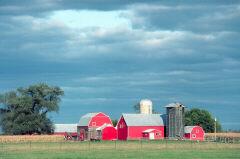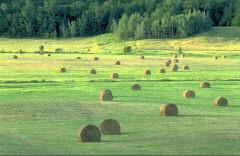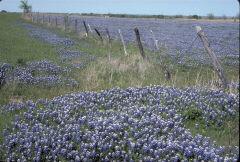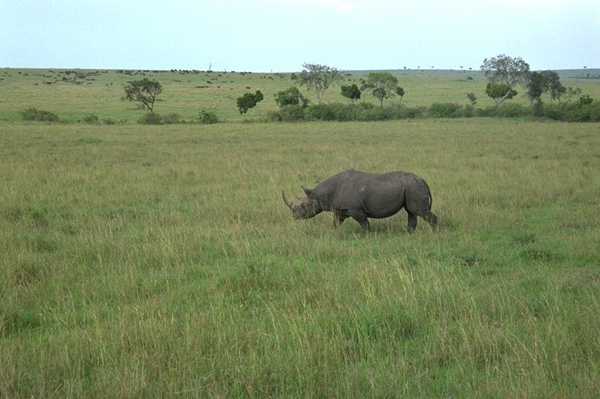What To Look For In A Field Site
 Locating a good
field site is usually something of an adventure. Key considerations include accessibility
and suitability for making observations. Although parks and playing fields in built up
areas are possible sites, the best sites are in rural areas or range land. The ideal site
is the middle of a large, flat, open, field, with unrestricted views in all directions. In
the real world, most sites are likely to be reasonably large and relatively flat fields
with more or less unrestricted views in most directions. Try to avoid areas with with
hills, cliffs, ravines, adjacent wood lots, sea shores, lake shores, ponds, buildings, or
isolated trees. All of these features are likely to distract or redirect the migrants. In
addition, most structures, particularly larger structures, interact with the wind to
generate complex patterns of turbulence. Avoid sites with obvious linear features.
Migrating butterflies tend to fly parallel to lines of trees, hedge rows, streams, and
even drainage ditches. A field site located in the rural setting pictured at right would
present several problems. Unless the butterflies are flying 30 m or more above the ground,
the buildings, silos, clusters of trees, and the abrupt break between the corn field and
pasture, would all present problems in interpreting directional data. If something like
the farm site is the only option, then moving further away from the buildings is probably
the best compromise. Unfortunately, the ideal site tends to be bland and lonely.
Locating a good
field site is usually something of an adventure. Key considerations include accessibility
and suitability for making observations. Although parks and playing fields in built up
areas are possible sites, the best sites are in rural areas or range land. The ideal site
is the middle of a large, flat, open, field, with unrestricted views in all directions. In
the real world, most sites are likely to be reasonably large and relatively flat fields
with more or less unrestricted views in most directions. Try to avoid areas with with
hills, cliffs, ravines, adjacent wood lots, sea shores, lake shores, ponds, buildings, or
isolated trees. All of these features are likely to distract or redirect the migrants. In
addition, most structures, particularly larger structures, interact with the wind to
generate complex patterns of turbulence. Avoid sites with obvious linear features.
Migrating butterflies tend to fly parallel to lines of trees, hedge rows, streams, and
even drainage ditches. A field site located in the rural setting pictured at right would
present several problems. Unless the butterflies are flying 30 m or more above the ground,
the buildings, silos, clusters of trees, and the abrupt break between the corn field and
pasture, would all present problems in interpreting directional data. If something like
the farm site is the only option, then moving further away from the buildings is probably
the best compromise. Unfortunately, the ideal site tends to be bland and lonely.
 The
hayfield to the left is an acceptable field site but there are several problems to
consider. Although the trees are probably too far away to distract migrants before you
have recorded their vanishing bearings, butterflies seeking roosting sites may head for
the woods in late afternoon or if the weather begins to deteriorate. The drainage ditch in
the mid ground may pose another problem. Such an obvious linear feature may be followed by
the butterflies when they are flying close to the ground, particularly in crosswind
conditions. Furthermore, the hills in the background will generate local wind patterns
that will affect even butterflies flying more than 30 m above the ground. For example, a
wind from behind and to the right of the observer may be channelled along the face of the
hills, altering the direction of high flying butterflies compared with those flying over
flatter terrain. Finally, turbulence generated by the rolls of hay in winds could also
affect the butterflies behaviour. In a situation like this, the best solution would
probably be to find a field further from the hills, with no drainage ditches, and no rolls
of hay.
The
hayfield to the left is an acceptable field site but there are several problems to
consider. Although the trees are probably too far away to distract migrants before you
have recorded their vanishing bearings, butterflies seeking roosting sites may head for
the woods in late afternoon or if the weather begins to deteriorate. The drainage ditch in
the mid ground may pose another problem. Such an obvious linear feature may be followed by
the butterflies when they are flying close to the ground, particularly in crosswind
conditions. Furthermore, the hills in the background will generate local wind patterns
that will affect even butterflies flying more than 30 m above the ground. For example, a
wind from behind and to the right of the observer may be channelled along the face of the
hills, altering the direction of high flying butterflies compared with those flying over
flatter terrain. Finally, turbulence generated by the rolls of hay in winds could also
affect the butterflies behaviour. In a situation like this, the best solution would
probably be to find a field further from the hills, with no drainage ditches, and no rolls
of hay.
 The attractive field on the right is not acceptable as a field site
because of the large areas of flowers. Although visibility is excellent, and it is highly
unlikely that the butterflies would even notice the fence, the flowers would be a major
distraction. As long as the butterflies are flying well above the ground (e.g. > 100
m)in tailwind conditions, we can probably assume that they will ignore large fields of
flowers. On the other hand, when the butterflies are flying within a few meters of the
ground, particularly if there is a light headwind, it is impossible to determine if they
are migrating, or just following the scent of a preferred species of flower. Migrants
flying over fields of flowers at intermediate at intermediate altitudes may or may not be
distracted. There simply are no data. However, I expect that the stimulus of large fields
of flowers would cause at least some individuals to descend and begin nectaring,
particularly in the late afternoon as the days migration begins to wind down. Since there
also appears to be large fields of grass in the vicinity, the best plan would be to locate
the site in one of these areas. Finally, because no single field site is ideal, there is
always the temptation to monitor several sites, each with a different combination of
advantages and problems. Unless your research program can have two or more observers
monitoring different sites simultaneously, observing the behaviour of migrating
butterflies at one site under a wide range of conditions will generally provide more
valuable data than observing them at several sites at different periods of times and under
a narrower range of conditions.
The attractive field on the right is not acceptable as a field site
because of the large areas of flowers. Although visibility is excellent, and it is highly
unlikely that the butterflies would even notice the fence, the flowers would be a major
distraction. As long as the butterflies are flying well above the ground (e.g. > 100
m)in tailwind conditions, we can probably assume that they will ignore large fields of
flowers. On the other hand, when the butterflies are flying within a few meters of the
ground, particularly if there is a light headwind, it is impossible to determine if they
are migrating, or just following the scent of a preferred species of flower. Migrants
flying over fields of flowers at intermediate at intermediate altitudes may or may not be
distracted. There simply are no data. However, I expect that the stimulus of large fields
of flowers would cause at least some individuals to descend and begin nectaring,
particularly in the late afternoon as the days migration begins to wind down. Since there
also appears to be large fields of grass in the vicinity, the best plan would be to locate
the site in one of these areas. Finally, because no single field site is ideal, there is
always the temptation to monitor several sites, each with a different combination of
advantages and problems. Unless your research program can have two or more observers
monitoring different sites simultaneously, observing the behaviour of migrating
butterflies at one site under a wide range of conditions will generally provide more
valuable data than observing them at several sites at different periods of times and under
a narrower range of conditions.

At last - a nearly perfect landscape for studying butterfly migration. The view to the horizon is essentially unlimited and distractions are minimal. Only one problem - obtaining permission from the local landholder (pictured above) may be a challenge.